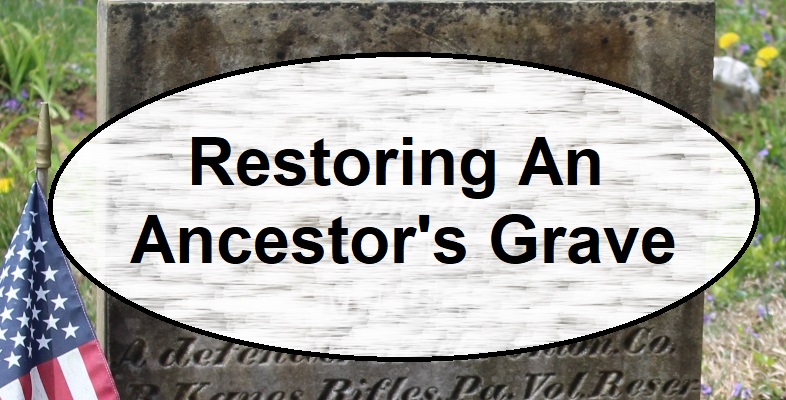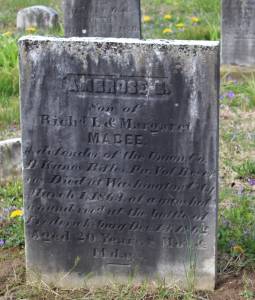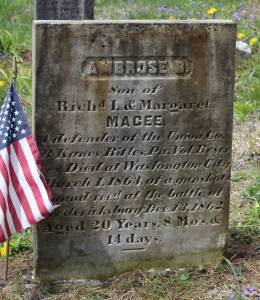
I knew exactly where to find the grave.
That sounds like the opening of a horror story, but this is not a horror story. It is, I hope, a story about restoration, literal and figurative.
The literal restoration is indeed that of a grave. The grave is that of Ambrose Magee, a Civil War Veteran who died of wounds received during the Battle of Fredericksburg a couple weeks prior to Christmas in 1862. Ambrose’s grave says he died on March 1, 1863. I would rather not imagine what the last two and one-half months of his life may have been like.

Even so, it does not take much research to get an idea. Louisa May Alcott, known for Little Women, wrote about her experiences nursing wounded soldiers from the battle. The work is called Hospital Sketches (available here) and, to my mind, it is an odd little work. It is as gruesome and as horrible as one might expect, but also full of gumption and good humor. It feels like Alcott is setting an example for the current behavior during bad times. Yes, it is the worst, so roll up your sleeves and get to work as though you would for any other task.
Trying to capture such feelings is one of the reasons I decided to tidy up Ambrose’s gravestone. There are other reasons. My daughter is working on a genealogy project and Ambrose, due to his military sacrifice, was deemed worthy of special attention. For extra motivation, this special attention coincided with the coming of Memorial Day. And of course, since we are all virtual prisoners in our homes, it felt useful to have a project that allowed a brief escape. Ambrose and his neighbors are at no risk from Covid-19.

For those willing to attempt a similar project, I have some pointers.
First, do your homework. Really, do your homework to the point you think it is finished, then double it. Cleaning a grave marker looks like it might be easy, but the only easy aspect is how easy it is to make an error. This is not a project that can be dismissed with a quick Google search or by asking Alexa or Siri. Sure, you get some quick answers, and those answers are often wrong. I was not satisfied until I read many professional documents produced by professional associations specializing in restoration work. I am going to offer a few pointers here, but I repeat: do your homework.
1.) Clean, do not restore. Cleaning is hard enough. Over decades (in the case of Ambrose more than 150 years) stone absorbs all sorts of gunk. Getting rid of that is enough work. Besides, anything beyond cleaning is also beyond your expertise. A cracked or tilted stone requires specialized skill. Unless you happen to be a thoroughly talented mason, this is not your job. In fact, if the stone is cracked or tilted or otherwise weakened, do not touch it at all. Otherwise you are at risk of disobeying the prime directive of all restoration work:
2.) Whatever else, do no harm. Do not make so much as a single additional scratch if it can be helped. Be exceedingly careful about your tools. Be aware that a cemetery is also a garden, so be aware of any environmental impact. This rule means there are a lot of “thou shalt nots”. Do not use bleach. Do not use ammonia. No wire brushes. No hard scrapers or other metal tools. Basically, you are allowed very mild bio-friendly soap, soft brushes and rags, perhaps a wooden paint stick, and elbow grease.
3.) Get permission if you can. It would take an especially hard person to stop you from doing what is, after all, a good deed; however, such hard people do exist. And let’s face it, you will be entering private property with the express purpose of changing something on that property. I looked into this issue quite a bit and ended up with more questions than answers. The burial plot, one would assume, was purchased as one the head stone itself. Are those purchases therefore assets that get passed from generation to the next the same as any other asset? Who, in bare legal terms, owns a specific grave? I did not find a satisfactory answer. Instead, I thought of it this way: it is the same as having a house in a neighborhood with an extremely strict and powerful homeowner’s association.
4.) Clean up after yourself.
5.) Take photos, both before and after.
For me, that last one proved especially valuable. It was the final part of the job, the figurative restoration. How satisfying to have a record of a job well done. Better yet, when others saw the photos on various social media, they were more than glad. A few expressed gratitude to a surprising degree. It was though they all knew something had to be done but were skittish about doing it. I guess it takes a special sort of person to spend a day in a nearly abandoned cemetery.
But as I said, I knew exactly where to find the grave. This part of the project involved no research at all. When I was in junior high, this graveyard was a short cut walking to and from school. In the end, it is nice to know that a weird kid, a really weird kid who used a cemetery as a daily walking path, could accomplish an activity appreciated by many.
Craig Magee
Editors note: Ambrose Magee’s findagrave.com entry can be found here: https://www.findagrave.com/memorial/39680236/ambrose-magee – KG
